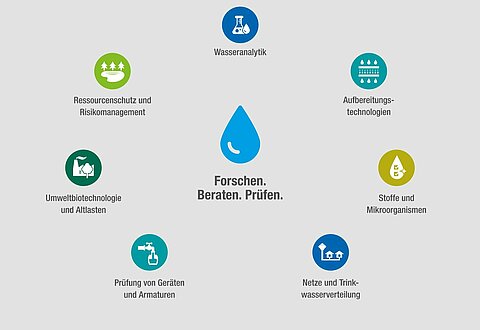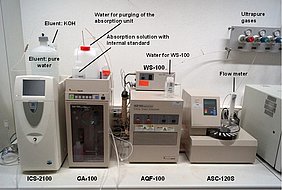In the project, water chemical surrogate parameter of adsorbable organic fluorine (AOF) was developed. The unknown percentage of the organofluorine in a water sample can be determined by comparison with target compound analysis.
Raw and drinking water contamination with per- and polyfluoroalkyl substances (PFASs) has caused huge difficulties for water supply since the perfluorinated compounds (PFC) scandal was reported in North Rhine-Westphalia in 2006. The target compound analysis only assesses a few important PFASs that are identified as being key compounds. Based on the variety of fluorinated chemicals contained in technical products (e.g. fluorosurfactants in aqueous film forming foams for fire-fighting or fluorinated chemicals for grease proving of food contact paper and their transformation products), only a fraction of the organofluorochemicals present in water are assessed.
Project results:
- A valid surrogate parameter was developed: AOF (adsorbable organically bound fluorine, limit of detection: 1 µg/l). It is based on the adsorption of organofluorine compounds on synthetic activated carbon and determination of organofluorine using combustion-ion chromatography (CIC).
- The developed method of analysis forms one of the principles for standardising a method to determine adsorbable organically bound fluorine, chlorine, bromine, iodine and sulphur (AOF, AOCl, AOBr, AOI, AOS); DIN working group NA 119-01-03-01-12 ion chromatography methods.
- Orienting AOF measurements in raw and drinking water with low levels of pollution and in municipal waste water, comparing the AOF with the organofluorine content determined in a parallel PFAS analysis, resulted in a large proportion (> 95 %) of unknown organofluorine.
- In a contaminated site hot spot (use of aqueous film forming foams for fire-fighting), about 50 % of the AOF could be explained using PFAS target analysis.
Publications
A. Wagner, B. Raue, H.-J. Brauch, E. Worch, F.T. Lange (2013) Determination of adsorbable organic fluorine from aqueous environmental samples by adsorption to polystyrene-divinylbenzene based activated carbon and combustion ion chromatography. Journal of Chromatography A 1295 82-89.
F.T. Lange, S. Willach (2014) Adsorbierbares organisch gebundenes Fluor (AOF) – ein weiterentwickelter Wasserqualitätsparameter zum Aufspüren von PFC-Hotspots [Absorbable organically bound fluorine (AOF) – a improved water quality parameter to trace PFC hotspots]. energie | wasser-praxis 9/2014, 66-69.
S. Willach, H.-J. Brauch, F.T. Lange (2016) Contribution of selected perfluoroalkyl and polyfluoroalkyl substances to the adsorbable organically bound fluorine in German rivers and in a highly contaminated groundwater, Chemosphere 145, 342–350.


![[Translate to English:] Prüfstelle-Produktprüfung_Teststand Test centre and product testing](/fileadmin/_processed_/0/9/csm_TZW-Karlsruhe_Pruefung_Geraete-Teststand_444204ae51.jpg)
























